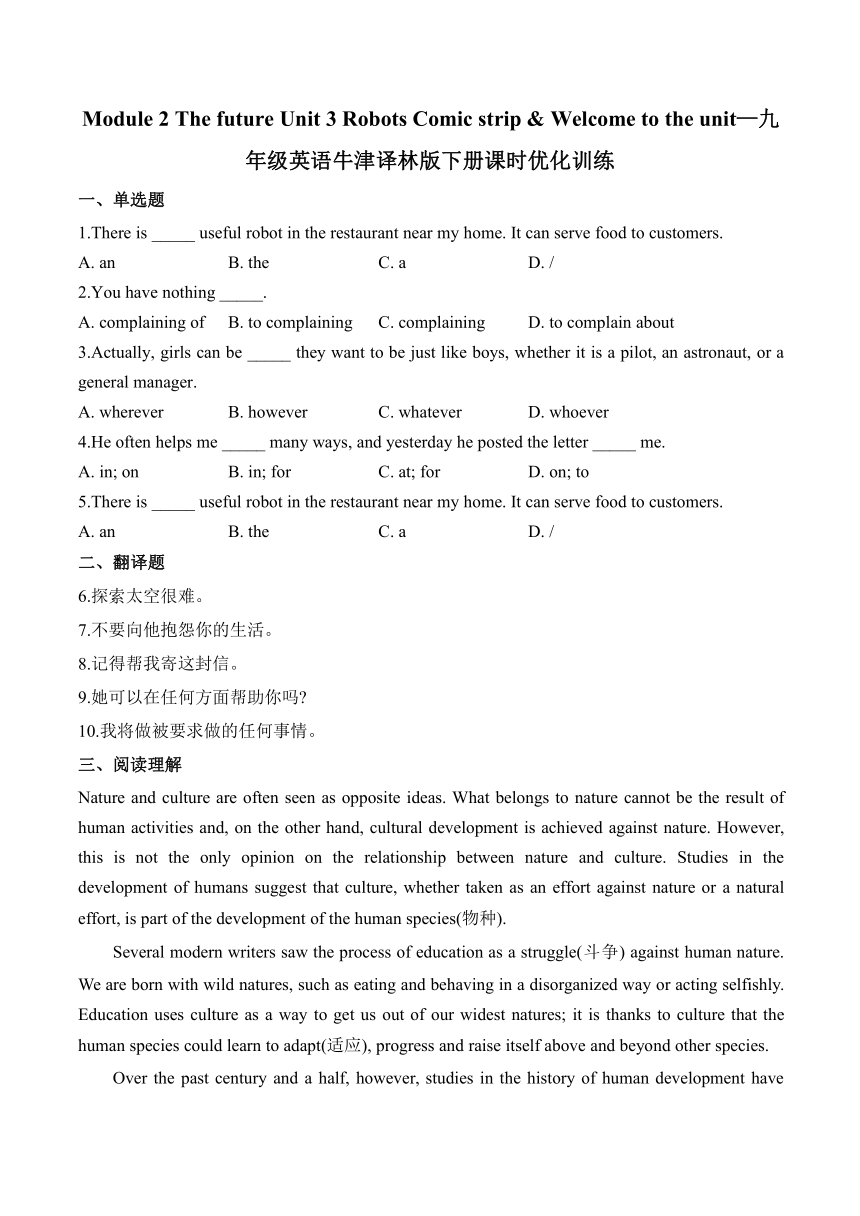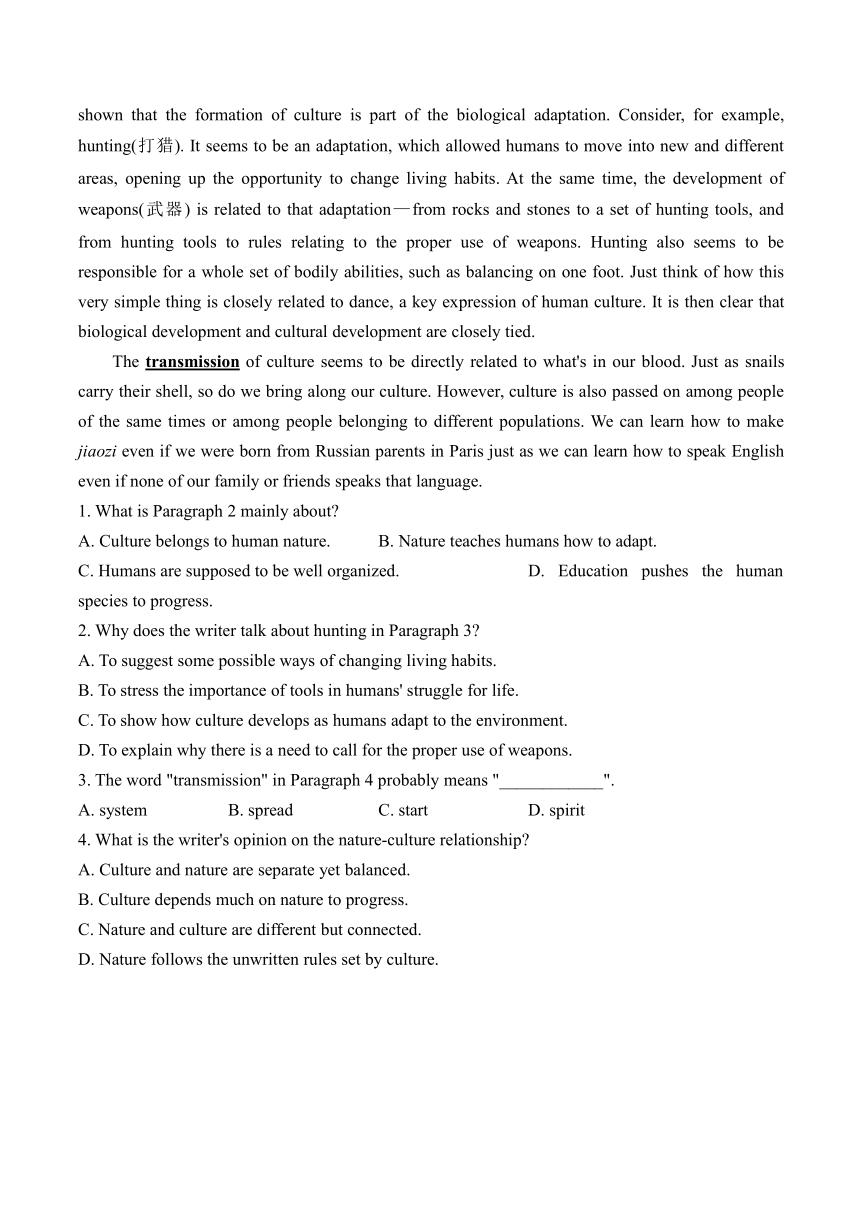Unit 3 Robots Comic strip & Welcome to the unit 九年级英语牛津译林版下册课时优化训练(含解析)
文档属性
| 名称 | Unit 3 Robots Comic strip & Welcome to the unit 九年级英语牛津译林版下册课时优化训练(含解析) |  | |
| 格式 | docx | ||
| 文件大小 | 19.6KB | ||
| 资源类型 | 教案 | ||
| 版本资源 | 牛津译林版 | ||
| 科目 | 英语 | ||
| 更新时间 | 2024-09-05 17:00:15 | ||
图片预览


文档简介
Module 2 The future Unit 3 Robots Comic strip & Welcome to the unit—九年级英语牛津译林版下册课时优化训练
一、单选题
1.There is _____ useful robot in the restaurant near my home. It can serve food to customers.
A. an B. the C. a D. /
2.You have nothing _____.
A. complaining of B. to complaining C. complaining D. to complain about
3.Actually, girls can be _____ they want to be just like boys, whether it is a pilot, an astronaut, or a general manager.
A. wherever B. however C. whatever D. whoever
4.He often helps me _____ many ways, and yesterday he posted the letter _____ me.
A. in; on B. in; for C. at; for D. on; to
5.There is _____ useful robot in the restaurant near my home. It can serve food to customers.
A. an B. the C. a D. /
二、翻译题
6.探索太空很难。
7.不要向他抱怨你的生活。
8.记得帮我寄这封信。
9.她可以在任何方面帮助你吗
10.我将做被要求做的任何事情。
三、阅读理解
Nature and culture are often seen as opposite ideas. What belongs to nature cannot be the result of human activities and, on the other hand, cultural development is achieved against nature. However, this is not the only opinion on the relationship between nature and culture. Studies in the development of humans suggest that culture, whether taken as an effort against nature or a natural effort, is part of the development of the human species(物种).
Several modern writers saw the process of education as a struggle(斗争) against human nature. We are born with wild natures, such as eating and behaving in a disorganized way or acting selfishly. Education uses culture as a way to get us out of our widest natures; it is thanks to culture that the human species could learn to adapt(适应), progress and raise itself above and beyond other species.
Over the past century and a half, however, studies in the history of human development have shown that the formation of culture is part of the biological adaptation. Consider, for example, hunting(打猎). It seems to be an adaptation, which allowed humans to move into new and different areas, opening up the opportunity to change living habits. At the same time, the development of weapons(武器) is related to that adaptation—from rocks and stones to a set of hunting tools, and from hunting tools to rules relating to the proper use of weapons. Hunting also seems to be responsible for a whole set of bodily abilities, such as balancing on one foot. Just think of how this very simple thing is closely related to dance, a key expression of human culture. It is then clear that biological development and cultural development are closely tied.
The transmission of culture seems to be directly related to what's in our blood. Just as snails carry their shell, so do we bring along our culture. However, culture is also passed on among people of the same times or among people belonging to different populations. We can learn how to make jiaozi even if we were born from Russian parents in Paris just as we can learn how to speak English even if none of our family or friends speaks that language.
1. What is Paragraph 2 mainly about
A. Culture belongs to human nature. B. Nature teaches humans how to adapt.
C. Humans are supposed to be well organized. D. Education pushes the human species to progress.
2. Why does the writer talk about hunting in Paragraph 3
A. To suggest some possible ways of changing living habits.
B. To stress the importance of tools in humans' struggle for life.
C. To show how culture develops as humans adapt to the environment.
D. To explain why there is a need to call for the proper use of weapons.
3. The word "transmission" in Paragraph 4 probably means "____________".
A. system B. spread C. start D. spirit
4. What is the writer's opinion on the nature-culture relationship
A. Culture and nature are separate yet balanced.
B. Culture depends much on nature to progress.
C. Nature and culture are different but connected.
D. Nature follows the unwritten rules set by culture.
答案以及解析
一、单选题
1.答案:C
解析:此处表示泛指且useful是以辅音音素开头的单词,其前应用a。故选C。
2.答案:D
解析:complain about sth.表示“抱怨某事”,此处应用动词不定式作后置定语,故选D。
3.答案:C
解析:此处引导表语从句,且在从句中作表语,应用whatever,表示“无论什么”,故选C。
4.答案:B
解析:前空考查in many ways, 意为“在很多方面”, 后空考查for sb., 意为“为某人”。
5.答案:C
解析:此处表示泛指且useful是以辅音音素开头的单词,其前应用a。故选C。
二、翻译题
6.答案:It's very difficult to explore outer space.
7.答案:Don't complain to him about your life.
8.答案:Remember to post the letter for me.
9.答案:Can she help you in any way
10.答案:I will do whatever I am asked to.
三、阅读理解
答案:1-4 DCBC
解析:1.段落大意题。根据第二段第一句和最后一句“Several modern writers saw the process of education as a struggle against human nature.”和“Education uses culture as a way to get us out of our widest natures...” 可知,人们把教育的过程看作是一场与人性的斗争,教育把文化作为一种方式,让我们摆脱最广泛的天性。所以本段想说明教育推动人类进步。故选D。
2.推理判断题。根据第三段第一二句“Consider, for example, hunting. It seems to be an adaptation, which allowed humans to move into new and different areas, opening up the opportunity to change living habits.” 可知,打猎似乎是一种适应,使人类能够进入新的和不同的地区,打开改变生活习惯的机会。文章提到打猎是为了展示文化是如何随着人类适应环境而发展的。故选C。
3.词句猜测题。根据最后一段第一二句“The transmission of culture seems to be directly related to what’s in our blood. Just as snails carry their shells, so do we bring along our culture.” 可知,文化的传播似乎与我们血液中的东西直接相关。就像蜗牛带着它们的壳一样,我们也带着我们的文化。所以此处“transmission”的意思是“传播”,故选B。
4.观点态度题。根据第一段最后一句“Studies in the development of humans suggest that culture, whether taken as an effort against nature or a natural effort, is part of the development of the human species.” 可知,作者认为文化,无论是作为一种反对自然的努力还是自然的努力,都是人类物种发展的一部分,作者认为自然和文化之间是对立且密切联系的。故选C。
一、单选题
1.There is _____ useful robot in the restaurant near my home. It can serve food to customers.
A. an B. the C. a D. /
2.You have nothing _____.
A. complaining of B. to complaining C. complaining D. to complain about
3.Actually, girls can be _____ they want to be just like boys, whether it is a pilot, an astronaut, or a general manager.
A. wherever B. however C. whatever D. whoever
4.He often helps me _____ many ways, and yesterday he posted the letter _____ me.
A. in; on B. in; for C. at; for D. on; to
5.There is _____ useful robot in the restaurant near my home. It can serve food to customers.
A. an B. the C. a D. /
二、翻译题
6.探索太空很难。
7.不要向他抱怨你的生活。
8.记得帮我寄这封信。
9.她可以在任何方面帮助你吗
10.我将做被要求做的任何事情。
三、阅读理解
Nature and culture are often seen as opposite ideas. What belongs to nature cannot be the result of human activities and, on the other hand, cultural development is achieved against nature. However, this is not the only opinion on the relationship between nature and culture. Studies in the development of humans suggest that culture, whether taken as an effort against nature or a natural effort, is part of the development of the human species(物种).
Several modern writers saw the process of education as a struggle(斗争) against human nature. We are born with wild natures, such as eating and behaving in a disorganized way or acting selfishly. Education uses culture as a way to get us out of our widest natures; it is thanks to culture that the human species could learn to adapt(适应), progress and raise itself above and beyond other species.
Over the past century and a half, however, studies in the history of human development have shown that the formation of culture is part of the biological adaptation. Consider, for example, hunting(打猎). It seems to be an adaptation, which allowed humans to move into new and different areas, opening up the opportunity to change living habits. At the same time, the development of weapons(武器) is related to that adaptation—from rocks and stones to a set of hunting tools, and from hunting tools to rules relating to the proper use of weapons. Hunting also seems to be responsible for a whole set of bodily abilities, such as balancing on one foot. Just think of how this very simple thing is closely related to dance, a key expression of human culture. It is then clear that biological development and cultural development are closely tied.
The transmission of culture seems to be directly related to what's in our blood. Just as snails carry their shell, so do we bring along our culture. However, culture is also passed on among people of the same times or among people belonging to different populations. We can learn how to make jiaozi even if we were born from Russian parents in Paris just as we can learn how to speak English even if none of our family or friends speaks that language.
1. What is Paragraph 2 mainly about
A. Culture belongs to human nature. B. Nature teaches humans how to adapt.
C. Humans are supposed to be well organized. D. Education pushes the human species to progress.
2. Why does the writer talk about hunting in Paragraph 3
A. To suggest some possible ways of changing living habits.
B. To stress the importance of tools in humans' struggle for life.
C. To show how culture develops as humans adapt to the environment.
D. To explain why there is a need to call for the proper use of weapons.
3. The word "transmission" in Paragraph 4 probably means "____________".
A. system B. spread C. start D. spirit
4. What is the writer's opinion on the nature-culture relationship
A. Culture and nature are separate yet balanced.
B. Culture depends much on nature to progress.
C. Nature and culture are different but connected.
D. Nature follows the unwritten rules set by culture.
答案以及解析
一、单选题
1.答案:C
解析:此处表示泛指且useful是以辅音音素开头的单词,其前应用a。故选C。
2.答案:D
解析:complain about sth.表示“抱怨某事”,此处应用动词不定式作后置定语,故选D。
3.答案:C
解析:此处引导表语从句,且在从句中作表语,应用whatever,表示“无论什么”,故选C。
4.答案:B
解析:前空考查in many ways, 意为“在很多方面”, 后空考查for sb., 意为“为某人”。
5.答案:C
解析:此处表示泛指且useful是以辅音音素开头的单词,其前应用a。故选C。
二、翻译题
6.答案:It's very difficult to explore outer space.
7.答案:Don't complain to him about your life.
8.答案:Remember to post the letter for me.
9.答案:Can she help you in any way
10.答案:I will do whatever I am asked to.
三、阅读理解
答案:1-4 DCBC
解析:1.段落大意题。根据第二段第一句和最后一句“Several modern writers saw the process of education as a struggle against human nature.”和“Education uses culture as a way to get us out of our widest natures...” 可知,人们把教育的过程看作是一场与人性的斗争,教育把文化作为一种方式,让我们摆脱最广泛的天性。所以本段想说明教育推动人类进步。故选D。
2.推理判断题。根据第三段第一二句“Consider, for example, hunting. It seems to be an adaptation, which allowed humans to move into new and different areas, opening up the opportunity to change living habits.” 可知,打猎似乎是一种适应,使人类能够进入新的和不同的地区,打开改变生活习惯的机会。文章提到打猎是为了展示文化是如何随着人类适应环境而发展的。故选C。
3.词句猜测题。根据最后一段第一二句“The transmission of culture seems to be directly related to what’s in our blood. Just as snails carry their shells, so do we bring along our culture.” 可知,文化的传播似乎与我们血液中的东西直接相关。就像蜗牛带着它们的壳一样,我们也带着我们的文化。所以此处“transmission”的意思是“传播”,故选B。
4.观点态度题。根据第一段最后一句“Studies in the development of humans suggest that culture, whether taken as an effort against nature or a natural effort, is part of the development of the human species.” 可知,作者认为文化,无论是作为一种反对自然的努力还是自然的努力,都是人类物种发展的一部分,作者认为自然和文化之间是对立且密切联系的。故选C。
